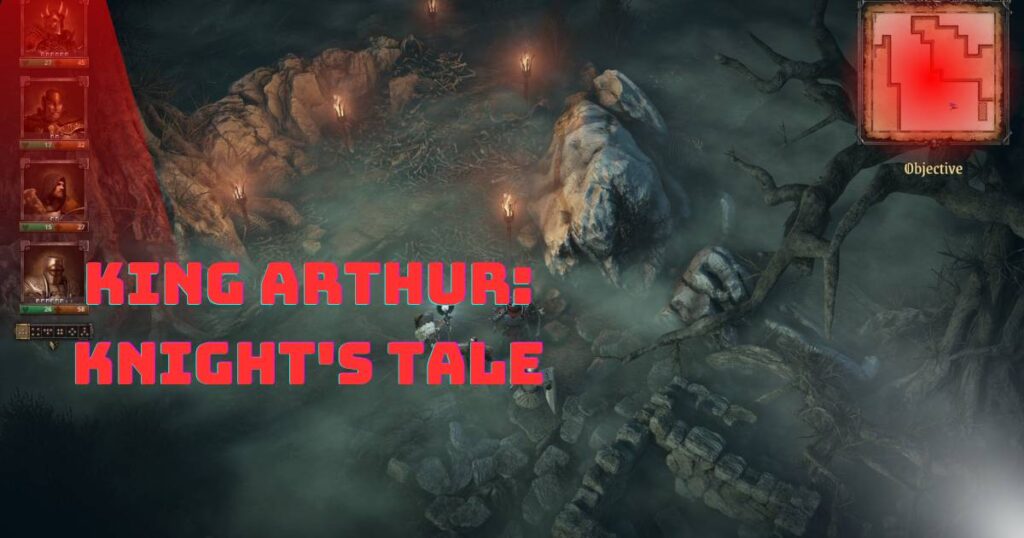King Arthur: Knight’s Tale (PS5, Xbox One, Xbox Series X)
In the grim darkness of Avalon, King Arthur is no hero but an undead scourge, reshaping the classic Arthurian legends into a narrative far removed from the familiar tales of chivalry and valor. ‘King Arthur: Knight’s Tale’ unfolds in the grim aftermath of the Battle of Camlann, where Arthur and his nemesis, Sir Mordred, lie fatally wounded. Defying the traditional end of their story, the game takes a dark twist as Arthur, spirited away to Avalon by the Lady of the Lake, becomes trapped in a twilight existence, his unending torment corrupting the once-idyllic realm into a land of nightmares.
The Lady of the Lake, in a desperate move to salvage Avalon, resurrects Sir Mordred. Tasked with a daunting mission, Mordred must traverse the now bleak and distorted Avalon, a land teeming with dark magic and mythical beasts, remnants of Camelot’s fallen grandeur, to confront and end Arthur’s accursed reign.

Set against a tapestry of dark fantasy that weaves together historical and mythical elements, the game creates a vivid backdrop where the magical and the medieval intersect, casting the Dark Ages in a new, eerie light. The narrative delves deep into themes of redemption, the intoxicating lure of power, and the far-reaching consequences of conflict, crafting a story that is as haunting as it is engaging.
Gameplay Mechanics
Core Tactical RPG Gameplay:
King Arthur: Knight’s Tale is rooted in the tactical RPG genre, emphasizing strategic depth through turn-based combat. Players engage in battles on grid-based maps, where careful planning and tactical foresight are crucial to victory. The combat system allows for a blend of movement, attacks, and the use of special abilities, each consuming action points (AP) that dictate what a character can do in their turn. This system rewards thoughtful positioning, anticipation of enemy moves, and effective use of each character’s unique abilities.
Exploration and Squad Selection/Management:
The game encourages exploration, with players venturing into a dark and twisted version of Avalon. As Sir Mordred, players must rebuild Camelot and gather a new Round Table of knights, each with their own backstories, personalities, and motivations. The process of selecting and managing your squad is integral, as characters not only bring their combat prowess to the field but also their narrative arcs and interactions. This layer of squad management extends beyond the battlefield, affecting the storyline and player decisions.
Leveling System and Character Progression:
Combat success is directly linked to character progression, with knights leveling up through experience gained in battles. This progression system allows players to enhance their characters’ abilities, unlock new skills, and improve their stats. The level-up mechanic is designed to make each victory feel rewarding, as it not only advances the plot but also strengthens your knights, making them more formidable in future encounters.
Class-Based System:
King Arthur: Knight’s Tale employs a class-based system that significantly influences gameplay style and strategy. Each knight belongs to a specific class, such as Champions, Archers, Defenders, Vanguards, and Mages, each with unique abilities and roles in combat. Champions might excel in dealing heavy damage, Archers in ranged attacks, Defenders in absorbing damage, Vanguards in mobility and swift strikes, and Mages in casting spells and support abilities. This diversity encourages players to mix and match their squad composition based on the mission at hand and the challenges they expect to face, leading to a rich tactical experience where each class’s strengths and weaknesses must be considered.
Base Management
In King Arthur: Knight’s Tale, Camelot serves as the central hub and backbone of your strategic operations. This legendary fortress, now in ruins, must be rebuilt and restored to its former glory, offering a range of strategic and gameplay benefits. The rebuilding of Camelot is not just a narrative device but a core gameplay element that impacts the effectiveness of your knights in combat and the overall progression through the game.
Key Facilities in Camelot:
- Cathedral: The Cathedral is a critical structure within Camelot, serving as a healing sanctuary for your knights. Upgrading the Cathedral enhances its healing capabilities, allowing knights to recover from injuries and ailments more quickly and effectively. This rapid recovery is essential for maintaining a ready and robust force, capable of taking on the challenges that lie in Avalon.
- Hospice: The Hospice plays a vital role in the rehabilitation of your knights, addressing more severe injuries and conditions that cannot be handled by the Cathedral alone. Upgrades to the Hospice reduce recovery times and improve the overall health of your knights, ensuring that they are battle-ready sooner and less likely to be sidelined by injuries sustained in combat.
- Training Grounds: The Training Grounds are where your knights hone their skills and gain valuable experience. Upgrading this facility allows for faster leveling up of your knights, even those not currently active in your party. This ensures that all members of the Round Table can keep pace with the increasing threats and challenges, making your army more versatile and adaptable.
Impact on Gameplay:
The choices you make in rebuilding and upgrading Camelot directly impact your knights’ effectiveness in combat and your strategic options. Each facility provides tangible bonuses and enhancements that can turn the tide in challenging battles. For instance, a well-upgraded Cathedral ensures your knights are always in top fighting condition, while an advanced Training Grounds can quickly elevate a newly recruited knight to a seasoned warrior, ready to face Avalon’s dangers.
Moreover, the management of Camelot requires careful resource allocation and prioritization. Deciding which buildings to upgrade first or invest more heavily in can significantly affect your campaign’s success. These decisions add a layer of strategic depth to the game, extending beyond the battlefield to the very heart of Camelot itself. Balancing these considerations is key to forging a path through the darkened lands of Avalon and ultimately confronting the threats that lie ahead.
Combat and Missions
In King Arthur: Knight’s Tale, combat is depicted as challenging and intense, requiring strategic thinking and careful planning. Players command a group of grizzled and flawed versions of Arthurian characters, each with their own unique abilities and personal demons. This darker, more nuanced portrayal of legendary figures adds depth to the gameplay, as players must navigate both the physical and psychological battles their knights face.
Despite the game’s engaging combat mechanics and depth of character development, some criticisms point to a certain level of repetitiveness in the combat scenarios. However, these are often offset by the variety of enemies faced, from undead knights to mythical creatures, which keeps encounters fresh and requires players to adapt their strategies. The combat is noted for its satisfyingly brutal effects, lending a visceral feel to each victory and defeat.
The mission structure in King Arthur: Knight’s Tale does offer more than straightforward combat scenarios. While the core of the game revolves around tactical battles, many missions incorporate environmental puzzles and decision-based situations that affect outcomes and the narrative’s progression. These elements introduce additional layers of strategy, requiring players to consider not only their moves in combat but also the broader implications of their choices within the game’s world.
In one notable mission, players are faced with a choice-based situation involving a dispute between two brothers, each claiming leadership over a strategic stronghold. The decision on whom to support not only influences the immediate battle tactics but also has long-term repercussions on available resources and alliances. Another example includes a puzzle where players must navigate a series of ancient, magical traps protecting a forgotten relic. Successfully disarming these traps requires careful planning and potentially sacrificing certain strategic advantages for future gains, showcasing the game’s depth in intertwining narrative choices with tactical gameplay.
Story and Characters
King Arthur: Knight’s Tale presents a mature and complex narrative, weaving themes of loyalty, betrayal, and the weight of choices into its dark retelling of the Arthurian legend. The story departs from traditional portrayals of chivalrous knights and noble quests, opting instead for a grittier, more nuanced exploration of character motivations and the consequences of power.
The game introduces a morality system that significantly impacts the storyline and gameplay. Player decisions influence the alignment of their version of Sir Mordred along axes of righteousness versus tyranny and adherence to the Old Faith versus Christianity. These choices affect not only the narrative’s direction but also the array of heroes available for recruitment to the Round Table. Certain decisions may unlock new allies or alienate existing ones, reflecting the game’s emphasis on the consequences of the player’s actions.
This emphasis on choice and consequence adds depth to the game’s characters, who are far from the idealized figures of legend. Instead, the knights and heroes in “King Arthur: Knight’s Tale” are presented with their flaws and personal demons prominently displayed. This darker tone allows for a more complex exploration of their motivations, as they grapple with internal and external conflicts in a world that no longer aligns with the black-and-white morality of their legends.
Technical Aspects and Atmosphere
While King Arthur: Knight’s Tale has been praised for its engaging gameplay and dark fantasy atmosphere, it’s important to acknowledge that some players have encountered technical glitches and performance issues. These can range from minor bugs to more significant interruptions that might detract from the overall player experience. Such issues, while not uncommon in complex video games, can be frustrating and potentially impact immersion and enjoyment. It’s crucial for players to be aware of these possible hiccups, though they don’t necessarily diminish the game’s many strengths.
The game’s dark fantasy atmosphere, on the other hand, is a standout feature that has garnered much praise. The developers have skillfully crafted a world that feels both ancient and otherworldly, using a palette of muted colors, shadowy corners, and ethereal lighting to evoke a sense of decay and mystery. This visual style, combined with the game’s sound design, which features haunting melodies and the eerie sounds of a world teetering on the brink of darkness, contributes significantly to the overall atmosphere.
Specific examples of the game’s atmospheric success can be found in the design of the environments and characters. The ruins of Camelot, for example, are rendered with a level of detail that suggests a rich history now fallen into despair. The lighting in these scenes often plays with contrast, casting long shadows that can hide dangers or highlight the stark beauty of the game’s architecture. The character designs also reflect the game’s dark tone, with armor and weapons that bear the scars of countless battles, and facial expressions that convey the weight of their grim quests.
Conclusion
King Arthur: Knight’s Tale stands out for its atmospheric world-building and a compelling twist on the familiar Arthurian legends, offering a dark and mature narrative that delves into themes of loyalty, betrayal, and the consequences of choice. The game’s rich, dark fantasy atmosphere is brought to life through meticulous visual and sound design, immersing players in a hauntingly beautiful rendition of Avalon. The tactical RPG gameplay, characterized by strategic depth and a complex morality system, adds layers of engagement, making each decision and battle feel impactful. You can play the game here.
However, potential performance hiccups and some gameplay repetition have been noted, which could detract from the overall experience for certain players. Despite these issues, the game’s unique take on a well-known mythology and its strong narrative focus make it a compelling pick for fans of Arthurian legends and tactical RPG enthusiasts who value story and atmosphere as much as strategic gameplay.










![Resolving Payday 3 Matchmaking Error: [October 2024]](https://technicalgeneralist.com/wp-content/uploads/2024/09/Payday-3-Matchmaking-Error-150x150.jpg)










